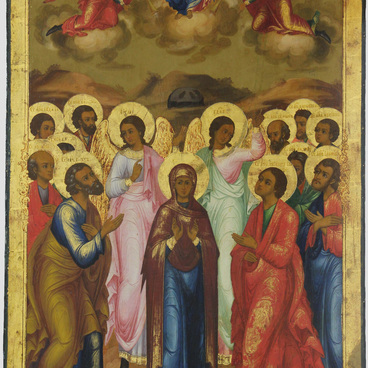1 / 8
Resurrection - Descent into Hell
Creation period
The icon was created in 1760-1780s, and its frame, in the 19th century
Dimensions
110x92 cm
109x92x4.5 cm
109x92x4.5 cm
Technique
Wood, alloy of gold and silver, tempera
Exhibition
0
Open in app#1
Unknown author
Resurrection — Descent into Hell
#3
#2
In the 18th century, complex iconographic compositions started to appear. ‘Resurrection — Descent into Hell’ is one of them. The theme of Jesus Christ’s descent into hell is not described in the canonical writings, the New Testament includes only sporadic mentions of the stay of Christ in the underworld. It is believed that he read a sermon there, freed the souls of the righteous, and brought the Old Testament prophets, as well as the first people Adam and Eve, out of hell.
#9
History
#6
The icon from the collection of the State Art Museum of Khanty-Mansiysk was painted in the 1760-1780s. It consists of the central part and 64 additional icons or marginal scenes.
The icon was presumably created in Rostov; this is indicated by the images of Rostov princes, metropolitans and senior priests, who are depicted in the marginal scenes along with better known Christian saints.
#8
Iconography
#7
The centerpiece of the icon has the shape of a lozenge with ornately shaped edges. Jesus Christ is placed in the center, with shining rays around him, and carrying a banner like one that was used in the war against the pagans. Jesus is standing over an open tomb, near which the guards are sleeping. In the center, we can also see Mount Golgotha with three crosses: two robbers were crucified together with Christ: the Prudent and the Mad.
In the Orthodox tradition, the theme of Descent to Hell corresponded to the resurrection. There was no other image of Christ rising from the tomb until the 17th century, when it was supplemented with the ‘Resurrection of Christ.’ The subject of Resurrection was borrowed by Russian icon painters from European prints.
In the Orthodox tradition, the theme of Descent to Hell corresponded to the resurrection. There was no other image of Christ rising from the tomb until the 17th century, when it was supplemented with the ‘Resurrection of Christ.’ The subject of Resurrection was borrowed by Russian icon painters from European prints.
#4
Technique
#5
The icon was painted with powder paint on a wooden base, covered with linen fabric and levkas, a special mixture of chalk, glue and oil. The board was cut from the core of a linden log. In this part of the tree, the wood is not deformed during drying. To prevent the icon from being damaged by pests, its reverse side was coated with a repellent liquid or with boiled linseed oil. Gold hatching was applied to the tempera icon in small strokes. On this icon, the hatching is painted in an alloy of gold and silver.
The icon frame from the collection of the State Art Museum of Khanty-Mansiysk was made almost a century later. Thin sheets of brass were embossed with a floral pattern, using a relief block. Then they wrapped the frame into the plates made in this way and covered it with gold leaf.
The icon came to Khanty-Mansiysk from Saint-Petersburg, where it was kept in the collection of Russian antiquities belonging to Viktor Samsonov.
The icon came to Khanty-Mansiysk from Saint-Petersburg, where it was kept in the collection of Russian antiquities belonging to Viktor Samsonov.
#10
State Museum of Fine Arts of Khanty-Mansiysk
read morehide
00:00
00:00
1x
Resurrection - Descent into Hell
Creation period
The icon was created in 1760-1780s, and its frame, in the 19th century
Dimensions
110x92 cm
109x92x4.5 cm
109x92x4.5 cm
Technique
Wood, alloy of gold and silver, tempera
Exhibition
0
Open in app
Share










